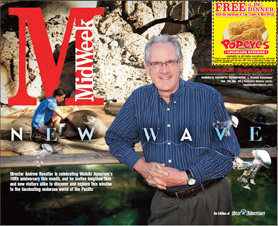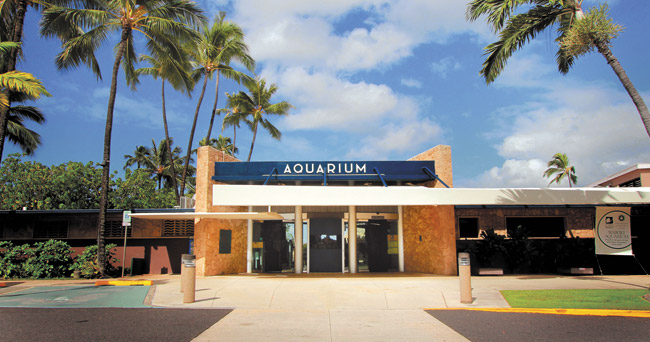New Wave
Waikiki Aquarium, Oahu’s window to the undersea world, is celebrating its 110th anniversary this month. Dive in and explore, as it’s bigger and better than ever with rare new residents and fascinating displays
What do you call a fish with no eyes? F sh.
What do you call a big fish that makes you an offer you can’t refuse?
The Codfather.
They know a lot of jokes like these at Waikiki Aquarium. Over its long history, they’ve heard them all.
As Waikiki Aquarium observes its 110th anniversary this month, we salute Hawaii’s window to the fascinating undersea world of the Pacific. Behind its glass doors and colorful fish tanks, the aquarium is a bastion of marine-and ocean-conservation knowledge that belies its popular perception as a school field trip and magnet for tourists. It is that, and so much more.
We offer fascinating facts and fishy tales about Waikiki Aquarium to dazzle and amaze you. We take you in-depth, and you never get wet. Dive in.
HISTORICAL
1) Just a trolley terminal. The aquarium was devised by Honolulu Rapid Transit visionaries Charles M. Cooke and James B. Castle as a way to get tourists to the unfrequented last stop on the Waikiki trolley line to Kapiolani Park.
2) Honolulu Aquarium opened March 19, 1904, and was located 60 yards ewa of where it sits today.
3) Its first exhibits featured 60 species of marine life, many supplied by local fishermen.
4) The aquarium expanded into research in 1912 and became the first marine laboratory in Hawaii.
5) It paved the way for the University of Hawaii’s current prestigious institutions, such as the Pacific Biosciences Research Center at Kakaako and Hawaii Institute of Marine Biology at Coconut Island, Kaneohe.
6) Frederick Potter (1904-40) was the first director, followed by Spencer Tinker (1940-72), Leighton Taylor (1975-86), Bruce Carlson (1987-2002) and Andrew Rossiter (2004-present).
“When I joined the aquarium in April 2004, I saw a firm foundation of marine education through exhibitry and immense potential. It is this potential that stimulates me today.” -Andrew Rossiter, director.
SEA LIFE
7) There are 400 marine organisms in the aquarium’s galleries and exhibits today.
8) Long-term residents include monk seal Maka Onaona from French Frigate Shoals (since 1984), giant trevally or ulua aukea caught off the Reef Runway (1993), zebra shark from Australia (1995), and emperor angelfish from Guam (1998).
9) The longest-living giant clam in any aquarium – more than 31 years – is in the Barrier Reef exhibit.
10) Waikiki Aquarium was first in the world to display Hawaiian monk seals and to breed mahimahi (dolphinfish).
11) It is the first in the U.S. to display and breed nautilus, display black-tipped reef sharks, giant clams, live corals and several species of butterflyfish and angelfish.
12) It pioneered the keeping and propagation of corals in captivity and has the largest collection of living corals in any public aquarium.
13) Many rare fish are at the aquarium, including the bearded armorhead (Evistias acutirostris), the only ones displayed outside of Japan.
14) Deep-water invertebrates in the Into the Deep exhibit include deep-sea shrimps, urchins and sea stars.
15) Waikiki Aquarium is the only place in the world to view the peppermint angelfish, collected in Palau by Dr. Richard Pyle of Bishop Museum at a depth of 450 feet. It also has Abe’s angelfish, the only one of its kind in captivity worldwide.
“Our research explores the impact of regular feedings on choices made by fish. It is our hope that native reef fishes such as the sailfin tang and yellowfin surgeonfish can be raised and released as a kind of ‘biocontrol’ of invasive seaweed infested reefs.” – Celia Smith, professor of botany, University of Hawaii.
16) The aquarium’s Hawaiian monk seals recognize 15-20 hand signals that initiate everything from vocalizing to swimming laps of the pool.
17) Nine aquarium inhabitants are conditioned to be hand-fed in order to ensure proper nutrition.
18) Wrasses, common Hawaii reef fish, are found in the 1,400-gallon Kaleidoscope Sea tank.
19) Nearly all wrasses start out female, but are capable of becoming male at various stages of life. The changeable nature of this fish, besides its transgender shenanigans, extends to dramatic color chameleons as well.
20) The inner ear of most fish contains tiny flat bones called otoliths, by which age is known. These discs have rings on them, each one representing one year’s growth, similar to growth rings in trees.
“You can experience more aspects of the ocean in just half an hour at the aquarium than what most people, including avid ocean enthusiasts, will experience their entire lives. -Marcus R. Boland, co-chair, Friends of Waikiki Aquarium.
RESEARCH
21) Waikiki Aquarium is the first facility in the world to successfully propagate the chambered nautilus after constructing special temperature-controlled tanks simulating natural habitats.
22) Much of the aquarium’s research centers on the propagation of marine animals, including threatened and endangered Hawaiian corals, the Hawaiian seahorse, masked angelfish and inarticulate brachiopod.
23) Research helps to uncover the secrets of coral biology in order to shed light on imperiled environments. Coral reefs are under assault from an array of environmental stresses and human impacts.
24) Hawaiian monk seal research focuses on physiology and thermoregulation (body temperature). Hawaiian monk seals are one of the most threatened marine mammals in the world, with fewer than 1,200 remaining in the wild.
“I smell like fish every day in the elevator going home. But it is worth it. I love those seals.” -Nancy Magraudy, aquarium volunteer for 23 years and monk seal trainer.
NEW WAVE
25) Northwestern Hawaiian Islands exhibit features 65 rare fish and 200 coral collected from Papahanaumokuakea Marine National Monument. According to Randy Kosaki, chief scientist, National Oceanic and Atmospheric Administration, “It’s very unusual for a public institution to have things that unusual on display.”
26) Coming soon to the aquarium: a new Hawaiian Streams exhibit with overhead waterfalls feeding into a series of streams; new Seahorse, Seadragon and Pipefish Gallery; new Live Food Culture area; Marine Protected Areas and Conservation Gallery with two large coral reef exhibits.
27) A new hands-on learning center, Ocean Sciences Laboratory, will be designed and headed by an ocean scientist (being recruited).
“My daughter is a marine biologist. Last year our family swam with manatees while on vacation in Florida. We make it a point to visit aquariums all over the world, but none is as special as the one we have at home. -Faye Kurren, co-chair, Friends of Waikiki Aquarium.
PARTY ON!
28) Public is invited to a two-day 110th birthday celebration Wednesday, March 19, 9 a.m. to 1 p.m., and Saturday, March 22, 9 a.m. to 2 p.m. Admission costs only $1.10 both days.
29)Wednesday’s lure: Royal Hawaiian Band, free birthday cake, educational and informative activities, samples from Hard Rock Café.
30) Saturday Family Day: Marine Chalk Art, UH Rainbow Marching Band, “Honu By the Sea” musical performance, educational displays and activities, community partner booths.
For year-round programs and events, including the popular Ke Kani O Ke Kai summer music series, visit waikikiaquarium.org.
“Wonderful though the present aquarium is, our residents and visitors deserve a larger, better aquarium. Hawaii needs and deserves more. -Andrew Rossiter.







